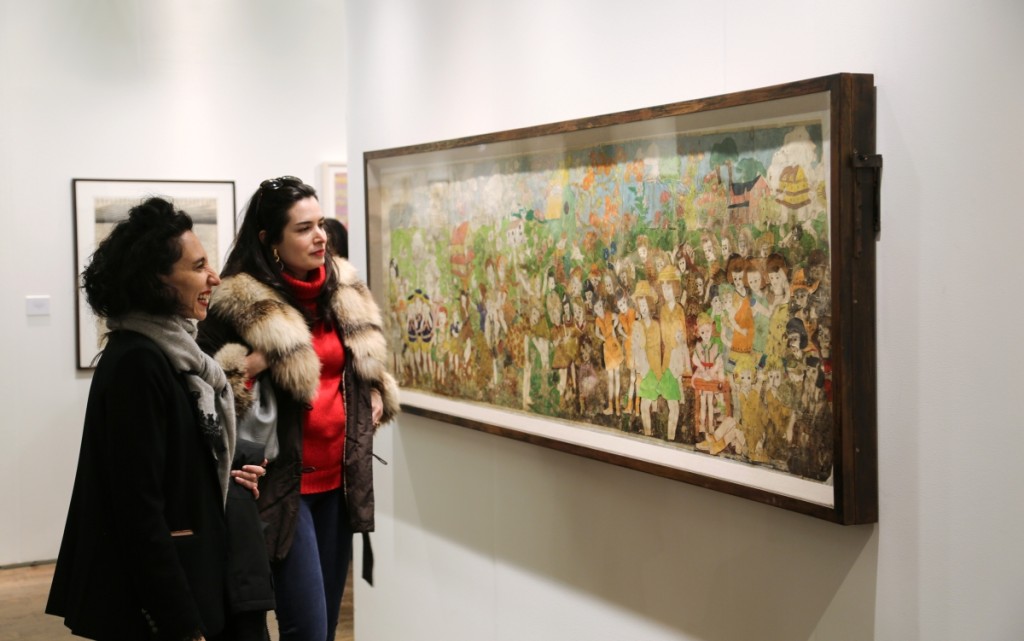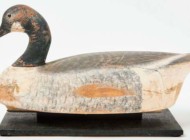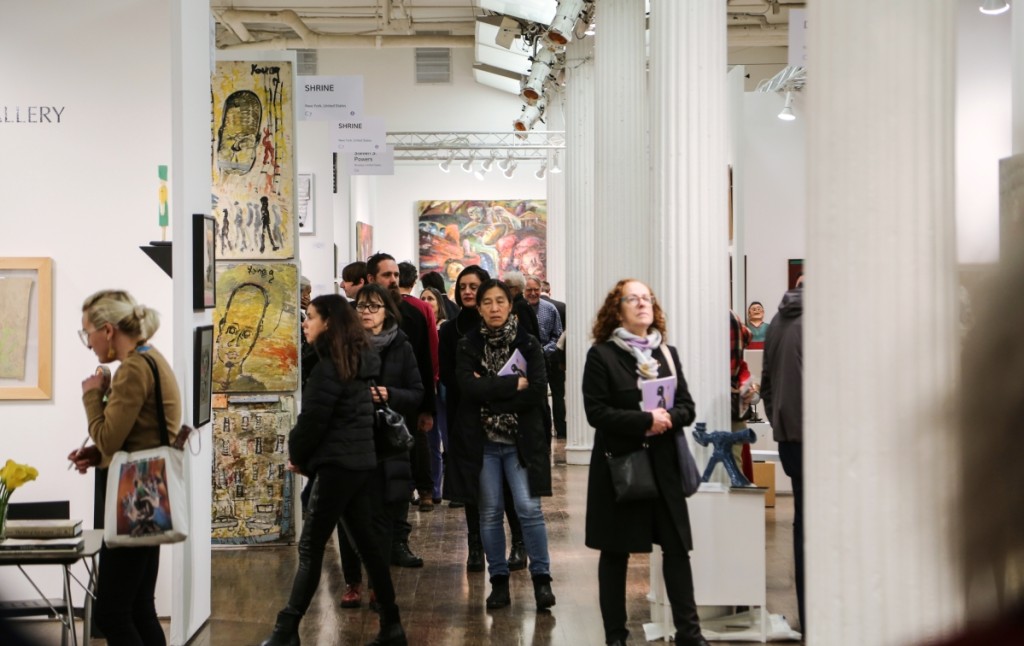
Visitors from around the world gathered at the Metropolitan Pavilion January 16-19 to see the 28th edition of the Outsider Art Fair.
Review and Photos by Greg Smith
NEW YORK CITY – The Outsider Art Fair returned to the Metropolitan Pavilion for its 28th edition January 16-19, bringing with it 65 dealers from ten countries and 35 cities.
This year’s show was on the move. Returning visitors who had developed a comfort with the floor plan in years past found themselves on new paths to discovery this edition, as the show reshuffled its booths and moved every dealer into a new space. The show also distanced itself from Americana Week, moving its tenure in New York City to the preceding week away from that schedule of events. It did not deter attendance, which was up eight percent this year to 12,500 visitors.
Among the show’s special programs, one of the most-buzzed-about was the curated space “Relishing the Raw: Contemporary Artists Collecting Outsider Art.” The booth was curated by critic Paul Laster. In it was found a Eugene von Bruenchenhein work in the collection of Maurizio Cattelan, a sculpture by Curtis Cuffie in the collection of Kenny Schachter, an Esther Hamerman from the collection of Nicole Eisenman, and a Helen Rae work in the collection of KAWS. Other contemporary artists included Jenny Holzer, Chris Martin, Nicolas Party, among others, who collected works from Morton Bartlett, Hawkins Bolden, Vahakn Arslanian and more.
Dealers to the show constantly speak of the neverending interest and conversations they have throughout the show, from the opening Wednesday through the closing Sunday. These conversations prove impactful and insightful to not only the attendees, but also the dealers, who are passionate students themselves.
Aarne Anton of American Primitive Gallery, New York City, exhibited a Navaho healing wand in painted wood from the mid-Twentieth Century. There were four of them originally, each for a cardinal direction, and he sold two long ago. He brought the remaining two to the fair and included them because he felt they dealt with healing, and that this was an appropriate time to provide that.
Anton related that an attendee walked into his booth and asked him not to sell the wands. She was the president of the American Synesthesia Association and she told Anton that from the moment she stepped into the building, she experienced a strong vibration in her feet that led her to his booth and the wand, where the vibration stopped. “She interpreted that to be the reason for the vibration and advised us not to sell it,” Anton told us. “Her feeling was that it was important to us. It was not because it had a native Navaho origin that she said this. She emphatically thought it had importance to us and we should not sell it.
“We removed the piece when she left and brought it home. I learned from the experience and don’t need to understand it to believe what she said. We have owned the healing wands for maybe 20 years. They have always been at the center of our house as works of art. The two we have we will now keep.” Anton was successful in dispatching a number of other works at the fair to new homes, including the largest sculpture in his booth, a carved wood Goddess of Liberty with an inset automobile headlamp in the belly and skeleton face, from a little-known Rochester, Minn., artist, which sold to a Texas collector.
On his first time exhibiting at the fair, Boston dealer Stephen Score found it energizing. Score had exhibited at the Winter Show the past two years and was pleased to make the transition. On the major differences he felt between the two, Score related he was no longer feeling as if his “balls were being squeezed by show vetters whose artistic vision had died in 1978.” His booth featured a selection of folk art objects that he described as one-offs, “objects on the leading edge of what might be considered not just Folk, but Outsider and beyond. Things you could never imagine seeing in front of you.”
“I had heard of, but was totally unprepared for, the throngs of people, in waves, coming through the show at all hours, every day and night,” Score said. “Most of them young people – looking, wanting to talk, to ask, to touch, to learn, to buy. I remembered my old days of looking at folk art when we all seemed to be learning about it at the same time. Exciting things, different things, that one might find in an attic or barn, not in galleries or Google. That collective excitement had diminished over the last few decades and shows, once chock-full of dealers and collectors parsing folk art, have changed or thinned out.” Score had an industrious show, recounting a number of sales, which included a 6-foot abstract metal rod sculpture in an open pyramidal shape by an anonymous woman who eroded metals for the Remington Arms Co in Ilion, N.Y., in the 1950s; an 8½-by-11-inch oil and pencil painting on Styrofoam tray by Sister Gertrude Morgan, “Praise Him All Ye Little Children – God is Love,” with the original $35 price tag on the back; a James Grunbaum painting, “Man in Profile”; a carved naughty pine and painted roulette wheel with a nude, 52-inch diameter; a carved pine sculpture of a Baptism that Score said was carved by a blind sculptor in the 1930s; a carved version of the then-newly erected Empire State Building; and a woolen and embroidered frog with old onyx eyes that Score had bought from Don Walters 30 years ago that had since resided on his mantel.
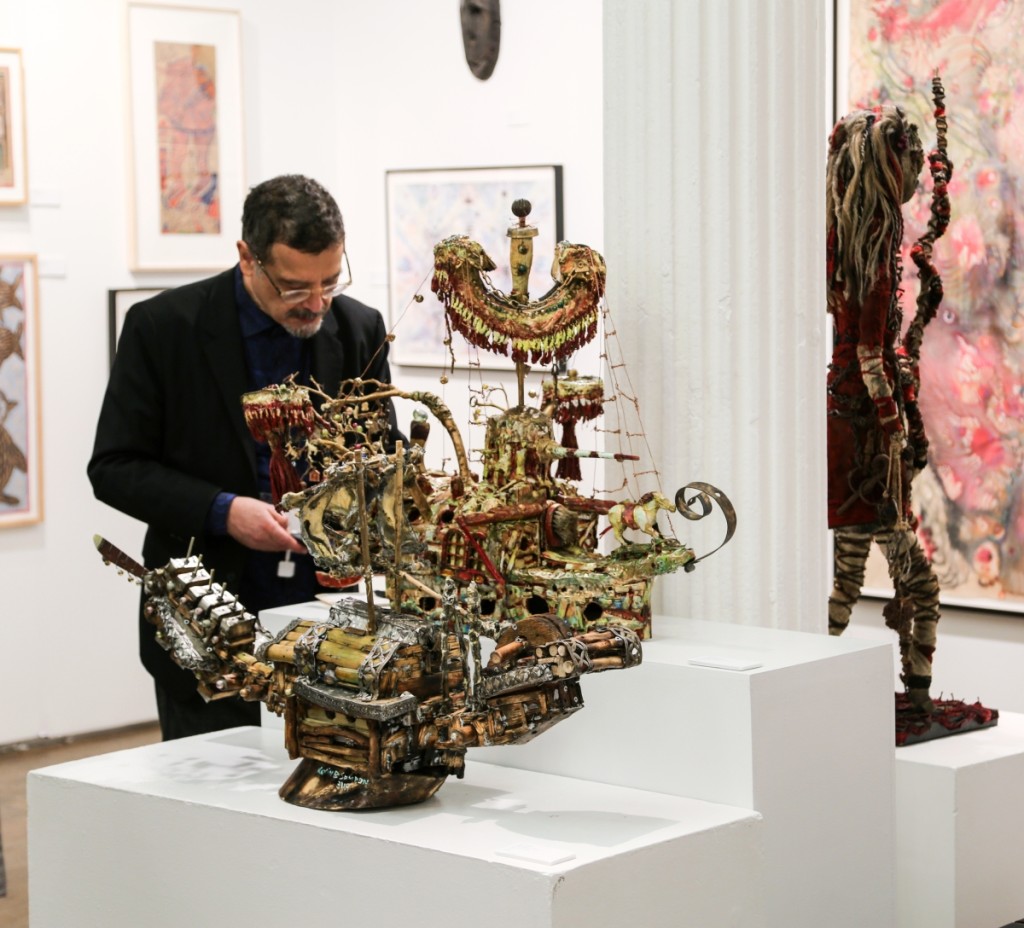
Contemporary works by artist Kevin Sampson were represented at Cavin-Morris Gallery, New York City. Seen here are two mixed media and found object works, “Shogun” and “USS Enterprise.”
Works from Leon D’Francelay, Prophet Royal Robertson and James “Son Ford” Thomas were on exhibit with Joshua Lowenfels Works of Art. D’Francelay was born in the Caribbean but became a naturalized US citizen following World War II. In the late 1950s, he became a guard at the Metropolitan Museum of Art and was there until his retirement in the 1980s. “He was talking of religion and life,” Lowenfels said, motioning to “Magnetism,” an oil on canvas room scene with bright colors and geometric perspectives. Two magnets sit on a green low coffee table in the center of the room, above them a rectangle featuring nails being forced into shapes by the magnets below. “His paintings were often symbolic, and we’ve lost his writings, of which there were supposedly many, so I can only read into it so much,” Lowenfels added. “His paintings are always staged; this one, I can’t help but wonder if the nails are symbols of the crucifixion, and the magnets are moving the nails in a way that is forming words. They float above, like that piece of parchment nailed to the cross. A lot of folk art has religion in it, but he approached it so differently. There’s a grandness in the execution of it.”
New York City dealer Marion Harris found success in debuting the work of Steven Hirsch, a court photographer for the New York Post who paints over his own front page photographs. Marion said Hirsch’s work drew as much attention as the memory maps of Joanathan Bessaci, whose detailed, layered Michelin maps replicate anatomical forms of the heart, brain and body with the arteries of the roads appearing similarly to those of the body. Marion said she sold three of six Bessaci pieces to a neurologist, a cardiologist and a psychiatrist. “I think the fair was one of the best in years,” Marion told us. “I was busy not just with sales, but with interesting and labor-intensive conversations – there seemed to be many who were new to Outsider Art and first-time visitors to the show. It was a pleasure to engage with them, describe the field and share their enthusiasm.”
Lindsay Gallery, Columbus, Ohio, found considerable interest in the carved wood sculptures of Quebec folk carver Cléophas Lachance, who upon retiring at 63, created an outdoor environment on his property called “Le Village Historique du Nord,” or “The Historical Village of the North.” The environment featured more than 40 homes, 300 carved citizens and more than 100 other buildings. Lachance had worked as a foreman, developing skills in carpentry and cabinetmaking over his career. The environment took him 15 years to build before he died in 1989. In carving village life, Lachance was visualizing a vanishing way of life. “People were really captivated by the figures and the incredible story of his huge outdoor environment,” Duff Lindsay told us. “We sold dozens of them, the majority of the body of work that we acquired.” The works on display varied, some included people at work, with a rifle slung over their shoulder or standing behind surveying equipment, while others depicted figures in front of their homes and subjects of domestic life. The gallery said he could carve up to four figures a day. Apart from the village, Lachance carved hundreds of other pieces that were meant for enjoyment and display.
Brooklyn dealer Steven S. Powers was sporting sold tags early on in the fair, including a 1994 miniature embroidered work by Ray Materson, which featured the artist in the throes of a sexual act with two women. Materson described the image as an event from his youth, where he skipped class in high school and wound up playing strip poker with two girls. Materson is seen lying flat on the floor with his arms outstretched like Christ in all but his briefs and a concerned look on his face, the women, with smiles on their faces, pulling at him and restraining him. “He thought it was going to be the best day of his life, but it ended up traumatizing him because they were more aggressive than he thought, laughing and teasing him,” Powers said. Also sold was a folk art sewer tile head of a woman, 5-1/8 inches high and from the early Twentieth Century; and a wood folk art carving of a bigfoot, 24 inches high and with hair all over his body. Powers said he made sales every day, ranging from $500 to $5,000. At the center of his booth was a 36-by-24-inch painting by Emile Branchard titled “Dark Trees.” Branchard was exhibited in the 1938 Alfred H. Barr Jr exhibition at MoMA, “Masters of Popular Painting.”
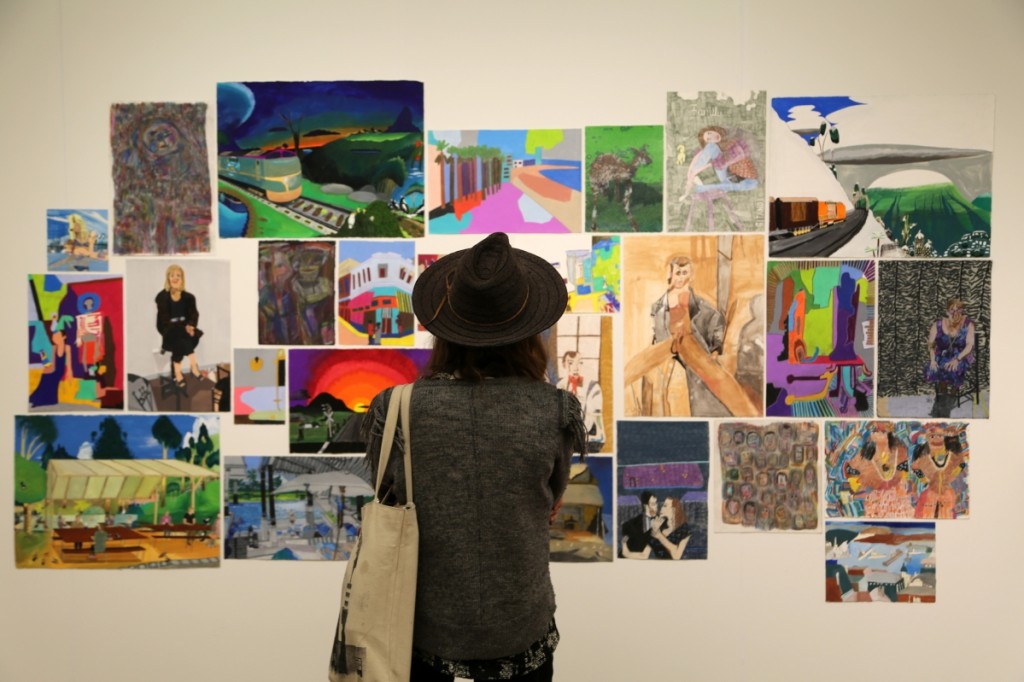
New York City gallery Dutton featured work from artists who worked out of studios at Arts Project Australia in Melbourne. These artists included Alvaro Alvarez, Paul Hodges, Lisa Reid, Miles Howard-Wilks, Anthony Romagnano and more. Ten percent of all sales went to the Wildlife Victoria Bushfire Emergency Appeal.
In addition to exhibiting his mainstay artists Eugene Von Bruenchenhein, Henry Darger and Lee Godie, Chicago-based Carl Hammer Gallery featured an untitled painted wood and applied half-spool tower construction by Earnest F. Becker that dated to 1898. It came with an original framed photo of the work at that time in an artist-made frame. Elsewhere in the booth was a painted tin cut-out sculpture, “Chameleon,” by David Butler. It was hung above a powerful Midwest folk artwork of a tin bucket decorated into a head with found materials. “The show maintained a high level of interest from the art buying community,” Hammer told us. “We did rather well. Not our best year, but right up there. Crowds were consistently in good numbers, and enthusiastically supportive…being very inquisitive.”
African, Haitian and Cuban artists were represented in the booth of Indigo Arts Gallery, Philadelphia. Among them were works from late Kenyan artist Kamante Gatura, who in his youth in the 1920s worked for Karen Blixen (aka Isak Dinesen), the author of Out of Africa. Gatura was a self-taught artist who captured life in Africa with crayon and colored pencils, and the gallery sold nearly all of the works they brought from him: one featuring three men around a fire with huts in the background, another with three animals around a singular stripped tree in a plain, and a third that features the natural order with lions and rhinoceros fighting and chasing prey in a grand plain. “Cheias Nascimento da Rosita (The Floods – Birth of Rosita),” a 2014 painted wood carving by Mozambique artist “Dino” Camordino Mustafa Jetha, documents a story that arose from the Cyclone Idai floods that plagued that country in 2000. The sculpture features three figures on a roof with their belongings, and that next to a tree with a mother and infant in it, a helicopter flying above to rescue them. As the flood enveloped their village, mother Amélia Mabuiango sought refuge in that tree with her 2-year-old son, where she gave birth to her child, Rosita. The story made international headlines and is largely credited with raising $500 million in relief efforts. “The story has entered Mozambique folklore,” gallery director Anthony Fisher told us. “I am happy to see a continuing trend that has been in the works for the last few years – an internationalization of the fair, with the addition of more art and dealers from beyond Europe and North America. Since most of the work I bring to the fair is from Africa, the African diaspora and Latin America, I am pleased to see galleries from Peru, Portugal and Japan and more work from Africa, Australia, Cuba, Haiti, Brazil, Iran and Mexico, to name a few. I saw more sculptural work and more work which might previously be “ghettoized” in ethnographic shows, such as masks from Mexico and Guatemala, and some exquisite Native American and African tribal work.”
Works from Gee’s Bend quiltmakers were on show with Kingston, N.Y., One Mile Gallery. This is the second time the gallery has shown quilts from the Alabama makers, and gallery director Janet Hicks said the quilts are a popular brand and people at the fair are familiar with them. Among her offerings were those by Mattie Ross, Rachel Carey George and Mary L. Bennett.
Among his sales, fair owner Andrew Edlin, who runs the Andrew Edlin Gallery, sold a 30-by-95-inch Henry Darger work shortly after opening. Edlin also exhibited architectural works by French artist Marcel Storr and drawings by early Twentieth Century Pennsylvania naïve artist Pearl Blauvelt. Shortly after opening, Edlin sold “Working at Home,” a circa 2000 work by Thornton Dial that measures 36 by 48 inches.
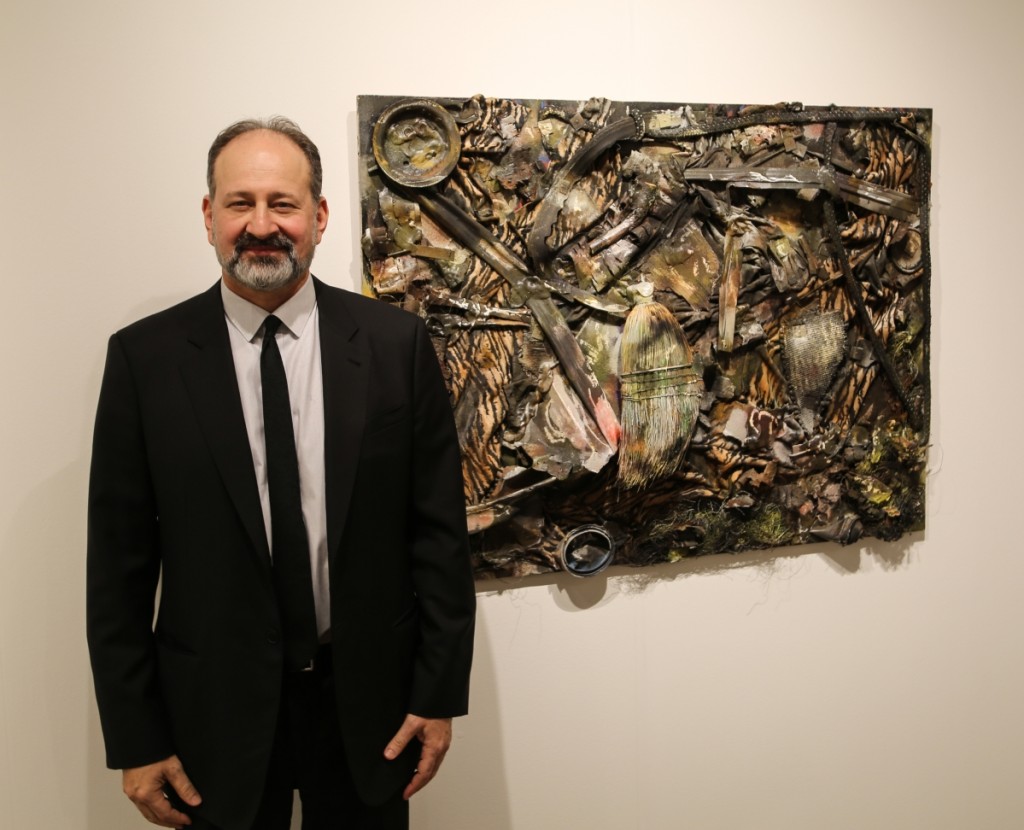
Fair owner Andrew Edlin stands next to “Working at Home,” a circa 2000 work by Thornton Dial that had just sold. Andrew Edlin Gallery, New York City.
It was a first time at the fair for New York City gallery Howard Greenberg, which showed off the work of photographer Vivian Maier. Maier, who photographed city life in Chicago and New York, was a nanny by profession and unknown as a photographer until her negatives were posthumously discovered. Greenberg’s exhibition aimed to provide both sides of Maier, her photographic observations and personal life. Maier developed and printed precious little of her own work, and on display was a selection of personal photos from Meier’s estate, photos she did develop. The gallery said they were able to sell a number of these domestic scenes, which included people she knew along with images that captured current events and her travels.
Sprawling and colorful fabric floral works by Milwaukee artist Rosemary Olson were on display with Portrait Society Gallery, Milwaukee, Wis. The first stanza from a poem written by the artist reads, “Flowers from above / Flowers created in love / Flowers not seen before / Flowers that express God’s love / Flowers that you and I do not know / Flowers that not one is the same / Flowers for you and I to name.” The gallery also featured a work by well-known Green Bay artist Norbert Kox, who passed away last year. “This was the last major work that seemed to be available,” gallery director Debra Brehmer said. “I had no idea if it would support the price, but it turns out there’s a lot of interest. We could have sold it four times. It’s been thrilling to have it here because people are happy to see his work and he’s loved.” That work, “Adam and Eve,” 70 by 50 inches, was priced at $40,000 and came with seven pages of text that the artist wrote describing every individual symbol within the work.
Two works from artist Renaldo Kuhler were quick sales at Ricco/Maresca Gallery, New York City. Kuhler worked for 30 years as a scientific illustrator for the North Carolina Museum of Natural Sciences. His personal work, which he created over a period of 60 years, was kept entirely private and centered around an imaginary country he envisioned named Rocaterrania. The gallery began representing the artist’s estate a year ago and launched a sold-out exhibition in May, 2019. The artist’s oeuvre approaches 1,500 works centered on storylines within Rocaterrania. “I originally looked at his work and others that included space and planets, and I thought he was interested in Science Fiction,” Frank Maresca told us. “But no, there was a movie studio in Rocaterrania that was making a Science Fiction movie.” Other storylines elucidate the city’s government, religion (Ojallaism), evolving language and alphabet, an organized labor service, a prison system, a university system and a Rocaterranian Olympics. Maresca released a recent podcast talking more about the artist, which follows a book, The Secret World of Renaldo Kuhler (Blast Books, 2017), and a documentary film, Rocaterrania (2009).
The show plans to return in 2021. For more information, www.outsiderartfair.com or 212-337-3338.

